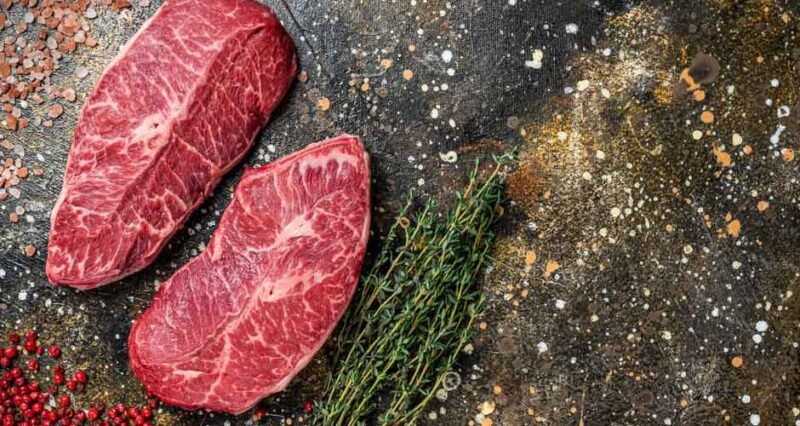
Think there is only one way of acquiring wagyu beef steaks for home cooking? Think again. Now you can get home grown American wagyu which you might even prefer to the Japanese version. This article explores what the similarities and differences are between these two types of wagyu beef, to find out who wins the title of best beef out there.
Let’s start with a general overview before we review the OG of wagyu: Japanese beef steaks.
What is a Wagyu?
A wagyu beef steak is not a type of cut, rather, it is a type of cow. You might still have a T-bone, fillet mignon, or rump steak of wagyu beef. Wagyu is the name the Japanese use to describe cattle – all cattle. However, the specialty doesn’t come from the cows themselves, but rather from the way they are treated. They are reared especially to create these steaks.
The life of a wagyu cow involves massaging, no stress, and fields so green they look like an oil painting. The herds have their every need tended to. Wagyu is an artform to the farmer. It is the constant care given to each of these cows which makes the meat different to any other type of steak out there.
Why is Wagyu Beef Different?
For a start, Wagyu – or Japanese native cattle – were almost driven to extinction during the wars. Wagyu were a staple working animal of the Japanese for around four or five thousand years. After this, the cow eventually became bred for food, rather than strength. However, by then the famous marbled pattern which makes wagyu beef so exceptional was already established.
Wagyu beef is different from other beef because the fat and meat are marbled throughout. There is no sirloin cut, where the fat tops the beef. The beef has the same pattern all over. The marbling of the fats allows them to break down easily as the meat cooks. This leads to a delicious steak dish which melts on the tongue.
Regardless of whether wagyu beef is different from other steaks or not, American wagyu and Japanese wagyu are strikingly similar.
Can you get American Wagyu Steak?
Of course you can. Wagyu cattle, often Kobe cows, are now spread throughout the world. Each country has a wagyu association, which sets out guidelines as to how the cows are to be treated for the meat to qualify for high price sales. America has the American Wagyu Association, while there is a similar association in Britain, France, and other countries.
Wagyu cattle were brought to America in 1975. The breeds began with 2 black and 2 red bulls, which started the process of creating herds. In 1989 the Japanese responded by raising tariffs on wagyu, sending prices ever higher. The US sought more cattle in the 1990’s and the Japanese responded by banning further exports of their prized cows. By then, the Americans already had a steady supply of wagyu from their own cattle.
Although the Japanese may still frown on wagyu raised outside of Japan, the cattle do exist. Not only do they exist, but they have similar tastes, both melt in the mouth, and are descendants of those same cattle which very nearly went extinct hundreds of years ago.
Differences Between American and Japanese Wagyu
Both American and Japanese wagyu descend from the same native Japanese breed of cow. Since they share an ancestry, they share the same taste, or at least a very similar one. There are few differences between the tow. Not to mention that both suppliers are constantly finding new ways to make that meat sweeter.
What’s Cheaper, American or Japanese Wagyu?
Far removed from the modern trends of soy beans and sustainable eating, the ancient art of cattle rearing is still alive – especially when it comes to prime cuts of wagyu. This meat is so famous that it comes with a high price tag, since it is so limited in production, those prices can soar, particularly if you are eating in a restaurant. Buying wagyu for home cooking is a cheaper alternative although it is still not inexpensive.
American wagyu steak is a little cheaper than Japanese wagyu, but not for the reason you may think. American cattle farmers take just as much care over these prime herds as Japanese wagyu farmers do. The slight difference in price comes from import and export taxes plus travel mileage.
Thus, if you order Japanese wagyu in Japan, it may be cheaper than American wagyu. But if you buy American wagyu in America, it will likely come without the air miles.
What’s Best: American or Japanese Wagyu?
The choice is yours. Since the two are so similar, only the tariffs separate them in terms of price.


